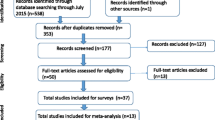Abstract
In this paper, we propose a model for predicting the dynamics of a generalized efficiency index for corporate computer networks operating under conditions of malicious cyber activity. The model represents the dynamics of the index as a function of the operational efficiency of a corporate network at each instant on a certain time interval. In this case, the level of operational efficiency of the network depends on the operational efficiency of its components and is described by a system of differential equations that take into account both malicious activity and the process of eliminating its effects. Under some simplifying conditions, we find analytical solutions of these equations, which significantly facilitates the prediction of the dynamics of the generalized efficiency index.
Similar content being viewed by others
REFERENCES
Saurenko, T.N., Anisimov, V.G., Anisimov, E.G., and Sonkin, M.A., Methodology control function realization within the electronic government concept framework, Int. J. Sci. Technol. Res., 2020, vol. 9, no. 2, pp. 6259–6262.
Anisimov, V.G., Anisimov, E.G., Zegzhda, P.D., and Suprun, A.F., The problem of innovative development of information security systems in the transport sector, Autom. Control Comput. Sci., 2018, vol. 52, no. 8, pp. 1105–1110. https://doi.org/10.3103/S0146411618080035
Zegzhda, D. and Stepanova, T., Achieving Internet of Things security via providing topological sustainability, Science and Information Conf. (SAI), London, 2015, IEEE, 2015, pp. 269–276. https://doi.org/10.1109/SAI.2015.7237154
Anisimov, V.G., Zegzhda, P.D., Anisimov, E.G., and Bazhin, D.A., A risk-oriented approach to the control arrangement of security protection subsystems of information systems, Autom. Control Comput. Sci., 2016, vol. 50, no. 8, pp. 717–721. https://doi.org/10.3103/S0146411616080289
Dakhnovich, A., Moskvin, D., and Zeghzda, D., An approach for providing industrial control system sustainability in the age of digital transformation, IOP Conf. Ser.: Mater. Sci. Eng., 2019, vol. 497, p. 012006. https://doi.org/10.1088/1757-899X/497/1/012006
Ivanov, D., Kalinin, M., Krundyshev, V., and Orel, E., Automatic security management of smart infrastructures using attack graph and risk analysis, Fourth World Conf. on Smart Trends in Systems, Security and Sustainability (WorldS4), London, 2020, IEEE, 2020, pp. 295–300. https://doi.org/10.1109/WorldS450073.2020.9210410
Cohen, F., Computer viruses: theory and experiments, Comput. Secur., 1987, vol. 6, no. 1, pp. 22–35. https://doi.org/10.1016/0167-4048(87)90122-2
Kozlov, D.A., Parandovskii, A.A., and Parandovskii, A.K., Entsiklopediya komp’yuternykh virusov (Encyclopedia of Computer Viruses), Moscow: Solon-R, 2010.
Lavrova, D.S., Alekseev, I.V., and Shtyrkina, A.A., Security analysis based on controlling dependences of network traffic parameters by wavelet transformation, Autom. Control Comput. Sci., 2018, vol. 52, no. 8, pp. 931–935. https://doi.org/10.3103/S0146411618080187
Pavlenko, E.Yu., Yarmak, A.V., and Moskvin, D.A., Hierarchical approach to analyzing security breaches in information systems, Autom. Control Comput. Sci., 2017, vol. 51, no. 8, pp. 829–834. https://doi.org/10.3103/S0146411617080144
Krundyshev, V. and Kalinin, M., The security risk analysis methodology for smart network environments, Int. Russian Automation Conf. (RusAutoCon), Sochi, Russia, 2020, IEEE, 2020, pp. 437–442. https://doi.org/10.1109/RusAutoCon49822.2020.9208116
Anisimov, V.G., Anisimov, E.G., Saurenko, T.N., and Zotova, E.A., Models of forecasting destructive influence risks for information processes in management systems, Inf. Control Syst., 2019, no. 5, pp. 18–23. https://doi.org/10.31799/1684-8853-2019-5-18-23
Saurenko, T.N., Anisimov, E.G., Anisimov, V.G., Suprun, A.F., and Kasatkin, V.V., Prediction of information security incidents, Probl. Inf. Bezop. Komp’yut. Sist., 2019, no. 3, pp. 24–28.
Zegzhda, P.D., Suprun, A.F., Anisimov, V.G., Tebekin, A.V., and Anisimov, E.G., Methodical approach to construction of models of forecasting of indicators of properties of information security systems, Probl. Inf. Bezop. Komp’yut. Sist., 2019, no. 4, pp. 45–49.
Anisimov, V.G., Anisimov, E.G., Zegzhda, P.D., Saurenko, T.N., and Prisyazhnyuk, S.P., Indices of the effectiveness of information protection in an information interaction system for controlling complex distributed organizational objects, Autom. Control Comput. Sci., 2017, vol. 51, no. 8, pp. 824–828. https://doi.org/10.3103/S0146411617080053
Kermack, W.O. and McKendrick, A.G., A contribution to the mathematical theory of epidemics, Proc. R. Soc. London. Ser. A, 1927, vol. 115, no. 772, pp. 700–721. https://doi.org/10.1098/rspa.1927.0118
Kotenko, I.V. and Vorontsov, V.V., Analytical models of network worm propagation, Tr. SPIIRAN, 2007, no. 4, pp. 208–224.
Zegzhda, P.D., Anisimov, V.G., Sem’yanov, P.V., Suprun, A.F., Anisimov, E.G., Saurenko, T.N., and Los’, V.P., Approach to the evaluation of the efficiency of information security in control systems, Autom. Control Comput. Sci., 2020, vol. 54, no. 8, pp. 864–870. https://doi.org/10.3103/S0146411620080362
Kephart, J.O. and White, S.R., Directed-graph epidemiological models of computer viruses, Proc. IEEE Computer Society Symp. on Research in Security and Privacy, Oakland, Calif., 1991, IEEE, 1991, pp. 343–359. https://doi.org/10.1109/RISP.1991.130801
Zegzhda, P.D., Anisimov, V.G., Suprun, A.F., Anisimov, E.G., Saurenko, T.N., and Los’, V.P., A model of optimal complexification of measures providing information security, Autom. Control Comput. Sci., 2020, vol. 54, no. 8, pp. 930–936. https://doi.org/10.3103/S0146411620080374
Bragg, R., Rhodes-Ousley, M., and Strassberg, K., Network Security: The Complete Reference, McGraw-Hill, 2003.
Anisimov, V.G., Zegzhda, P.D., Anisimov, E.G., Saurenko, T.N., and Kasatkin, V.V., Model and method for optimizing computational processes in parallel computing systems, Autom. Control Comput. Sci., 2019, vol. 53, no. 8, pp. 1038–1044. https://doi.org/10.3103/S0146411619080054
Anisimov, E.G., Anisimov, V.G., Gar’kushev, A.Yu., and Selivanov, A.A., Indicators of the effectiveness of interagency communications in the management of the defense of the state, Vopr. Oboronnoi Tekh. Ser. 16: Tekh. Sredstva Protivodeistviya Terrorizmu, 2016, nos. 7–8, pp. 12–16.
Author information
Authors and Affiliations
Corresponding authors
Ethics declarations
The authors declare that they have no conflicts of interest.
Additional information
Translated by Yu. Kornienko
About this article
Cite this article
Zegzhda, P.D., Anisimov, V.G., Anisimov, E.G. et al. Operational Efficiency of Computer Networks under Conditions of Malicious Cyber Activity. Aut. Control Comp. Sci. 55, 1020–1024 (2021). https://doi.org/10.3103/S0146411621080332
Received:
Revised:
Accepted:
Published:
Issue Date:
DOI: https://doi.org/10.3103/S0146411621080332




